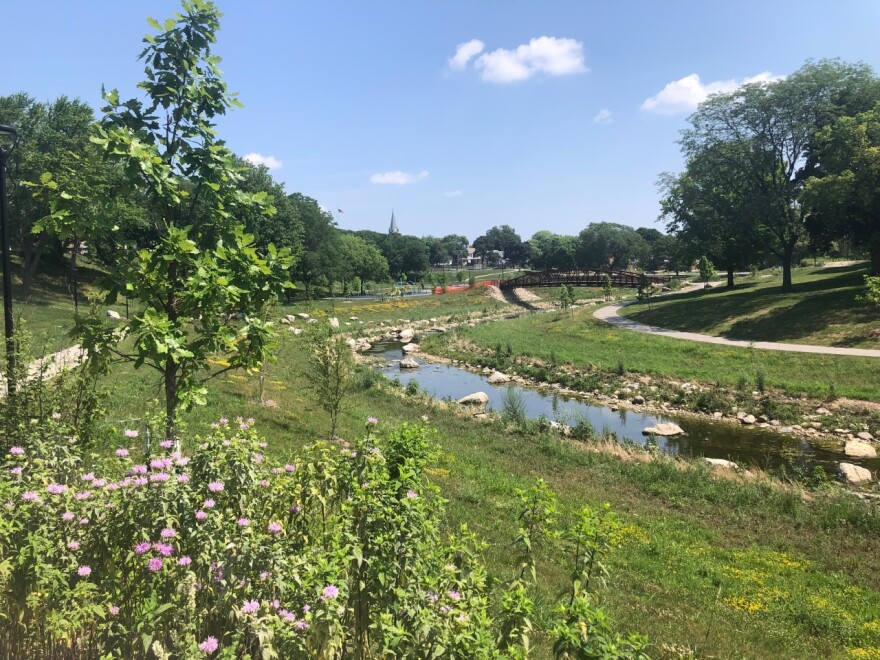As President Joe Biden tries to sell the nation on a huge infrastructure spending plan, the head of his Environmental Protection Agency came to Milwaukee Tuesday to push for the package.
EPA Administrator Michael Regan focused on the funding that the deal would provide for investments in water infrastructure. That could include projects that reduce the risk of flooding, improve safety and restore habitat.
Regan also said the spending package would pay for the replacement of lead pipes that provide drinking water to thousands of homes.
Local officials took the opportunity to show Regan an example of an existing water infrastructure project.
READ When It Comes To Flooding, Can Milwaukee Cope?
For an hour Tuesday morning, local and state officials hovered near a restored stretch of the Kinnickinnic River in Pulaski Park on Milwaukee’s south side.
Everyone, from Regan to members of the press, gravitated to the shade of trees, as Milwaukee Metropolitan Sewerage District (MMSD) Executive Director Kevin Shafer did the introductions.

Below, the Kinnickinnic sparkled in the sun, native plants dotting its shores.
Not so long ago, this stretch was channelized and lined with concrete. Every major storm brought with it the fear that someone might be swept into the flow.
READ South Side Neighbors Engage In Rebirth of Milwaukee's KK River
Now the river is gradually being returned to a more natural state, allowing the water to flow more slowly and spread out, making it more hospitable to wildlife and humans.
Milwaukee Mayor Tom Barrett said the city is learning to live with nature. “I think at one point the prevailing sentiment was let’s defeat nature and I think right now, far more successful for us has been, we’re fortunate to be part of of nature,” he said.
Pointing to the Kinnickinnic, Shafer interjected, “This all flows to Lake Michigan, which is our drinking water supply, so we’re protecting the Great Lakes, we’re restoring the lifeblood that feeds the lake.” He added, “It’s just really something to be proud of.”
This project is unfolding thanks to partnerships, including funding from the federal government.

Jennifer Wright, MMSD water course section manager, said the district is expert at figuring out how to engineer a naturalized river that can absorb heavier storms, but it’s also important to involve neighbors in planning.
“This river goes through their front yards, not necessarily their backyards. So, we wanted to make sure everyone knew about it and took ownership; like what kind of pedestrian bridge do you want, what type of playground would the community like, what color? They were little things, but any input whatsoever we did take it to heart and we included any feedback we received in our design,” Wright said.
Esperanza Gutierrez is one of those residents. Gutierrez became involved in the evolving stretch of the river and helped create the group KK River Neighbors In Action.
“If you go down, you can hear the babbling brook; you can forget the city and go back to nature and touch it. Again, it’s not just my park and it’s not just my street, but it’s ours and we have to maintain it for our children," she said.
EPA Administrator Michael Regan appeared to be moved.
“'Esperanza,' I think if I’m correct, 'esperanza' means hope. And I think you give us just so much hope that, that with this level of partnership we can realize what we need to with the government and our communities working together.” Regan said, “We don’t have to sacrifice, it doesn’t have to be either or and I think you all are demonstrating that we can have it all.”
He continued, "Milwaukee is doing exactly what we want to see the rest of the country doing — looking at ways to marry jobs, infrastructure, natural resources, protecting the planet, protecting communities. You guys have a winning recipe going on here and we want the world to see it and more importantly, we want other cities across this country to replicate what we see happening in the state."

It’s probably safe to say that everyone touring this slip of the Kinnickinnic is hoping the federal government delivers the robust bipartisan infrastructure package Regan was promoting during his stop in Wisconsin.
Milwaukee, for example, has lots more river naturalizing to achieve and more storm water to manage, not to mention 70,000 old lead service lines delivering drinking water to homes.
Regan said, “The proposal for the infrastructure framework means exactly what the president said — it would replace 100% of the lead pipes in this country. We know what lead pipes mean for public health especially for children. It’s important that we get it done.”
Next week, the EPA will be back in Milwaukee. This time to foster dialogue specifically on the experience of communities affected by lead in drinking water.
Have an environmental question you'd like WUWM's Susan Bence to investigate? Submit below.
_







